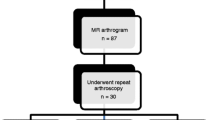Abstract
Objective
Imaging the shoulder in the position of flexion, adduction, and internal rotation (FADIR) may be useful in characterizing lesions of the posteroinferior labrum. The purpose of this preliminary study is to illustrate the diagnostic utility of FADIR positioning in the assessment and characterization of posteroinferior labral tears.
Materials and Methods
In the FADIR position, the arm is placed across the chest, with the hand on the contralateral shoulder and palm facing outwards. FADIR positioning was performed if there was a subtle or equivocal abnormality of the posteroinferior labrum on conventional MR arthrography sequences. A retrospective review of the charts of 9 people who were imaged using FADIR positioning in addition to routine MR arthrographic sequences of the shoulder was performed. The review included the indication for the study, documentation of presence of clinical posterior instability, and surgical correlation, where available.
Results
In all 9 patients, FADIR positioning helped confirm, exclude, or better characterize a posteroinferior labral abnormality by increasing the diagnostic confidence.
Conclusion
Flexion, adduction, and internal rotation positioning appears to be a useful adjunct in evaluating patients with equivocal or subtle posteroinferior labral abnormalities on conventional MR arthrography sequences.










Similar content being viewed by others
References
Bradley JP, Forsythe B, Mascarenhas R. Arthroscopic management of posterior shoulder instability: diagnosis, indications, and technique. Clin Sports Med. 2008;27:649–70.
Robinson CM, Aderinto J. Recurrent posterior shoulder instability. J Bone Jt Surg Am. 2005;87:883–92.
Millett PJ, Clavert P, Hatch III GFR, Warner JJP. Recurrent posterior shoulder instability. J Am Acad Orthop Surg. 2006;8:464–76.
Tibone JE, Bradley JP. The treatment of posterior subluxation in athletes. Clin Orthop Relat Res. 1993;(291):124–37.
Lamar DS, Williams GR, Iannotti JP, Ramsey ML. Posterior instability of the glenohumeral joint: diagnosis and management. Univ Pa Orthop J. 2001;14:5–14.
Antoniou J, Harryman II DT. Posterior instability. Orthop Clin North Am. 2001;32:463–73.
Vidal LB, Bradley JP. Management of posterior shoulder instability in the athlete. Curr Opin Orthop. 2006;17:164–71.
Papendick LW, Savoie III FH. Anatomy-specific repair techniques for posterior shoulder instability. J South Orthop Assoc. 1995;4:169–76.
Jbara M, Chen Q, Marten P, Morcos M, Beltran J. Shoulder MR arthrography: how, why, when. Radiol Clin North Am. 2005;43:683–92.
Hottya GA, Tirman PFJ, Bost FW, et al. Tear of the posterior stabilizers after posterior dislocation: MR imaging and MR arthrographic findings with arthroscopic correlation. AJR Am J Roentgenol. 1998;171:763–8.
Beltran J, Rosenberg ZS, Chandnani VP, et al. Glenohumeral instability: evaluation with MR arthrography. Radiographics. 1997;17:657–73.
Beltran J, Kim DH-M. MR imaging of shoulder instability injuries in the athlete. Mag Reson Imaging Clin N Am. 2003;11:221–38.
Tirman PF, Palmer WE, Feller JF. MR arthrography of the shoulder. Magn Reson Imaging Clin N Am. 1997;5:811–39.
Chandnani VP, Yeager TD, DeBerardino T, et al. Glenoid labral tears: prospective evaluation with MRI imaging, MR arthography, and CT arthrography. AJR Am J Roentgenol. 1993;161:1229–35.
Cvitanic O, Tirman PF, Feller JF, et al. Using abduction and external rotation of the shoulder to increase the sensitivity of MR arthrography in revealing tears of the anterior glenoid labrum. AJR Am J Roentgenol. 1997;167:837–44.
Song HT, Huh YM, Kim S, et al. Anterior-inferior labral lesions of recurrent shoulder dislocation evaluated by MR arthrography in an adduction internal rotation (ADIR) position. J Magn Reson Imaging. 2006;23:29–35.
Harish S, Nagar A, Moro J, et al. Imaging findings in posterior instability of the shoulder. Skeletal Radiol. 2008;37:693–707.
Resnick D, Kang HS, Pretterklieber ML. Shoulder. In: Resnick D, Kang HS, Pretterklieber ML, editors. Internal derangement of joints, vol 1. 2nd ed. Philadelphia: Saunders; 2007. p. 713–1122.
Kaplan LD, Flanigan DC, Norwig, et al. Prevalence and variance of shoulder injuries in elite collegiate football players. Am J Sports Med. 2005;33:1142–6.
Shah N, Tung GA. Imaging signs of posterior glenohumeral instability. AJR Am J Roentgenol. 2009;192:730–5.
Tung GA, Hou DD. MR arthrography of the posterior labrocapsular complex: relationship with glenohumeral joint alignment and clinical posterior instability. AJR Am J Roentgenol. 2003;180:369–75.
Saupe N, White LM, Bleakney R, et al. Acute traumatic posterior shoulder dislocation: MR findings. Radiology. 2008;248:185–93.
Simons P, Joekes E, Nelissen RG, Bloem JL. Posterior labrocapsular periosteal sleeve avulsion complicating locked posterior shoulder dislocation. Skeletal Radiol. 1998;27:588–90.
Yu JS, Ashman CJ, Jones G. The POLPSA lesion: MR imaging findings with arthroscopic correlation in patients with posterior instability. Skeletal Radiol. 2002;31:396–9.
Kim SH, Ha KI, Yoo JC, Noh KC. Kim’s lesion: an incomplete and concealed avulsion of the posteroinferior labrum in posterior or multidirectional posteroinferior instability of the shoulder. Arthroscopy. 2004;20:712–20.
Lee GY, Choi JA, Oh JH, Choi JY, Hong SH, Kang HS. Posteroinferior labral cleft at direct CT arthrography of the shoulder by using multidetector CT: is this a normal variant? Radiology. 2009;253(3):765–70.
Acknowledgements
We extend thanks to all MR technologists at St. Joseph’s Healthcare for their help with this study. We would also like to thank Glen Oomen for preparation of the illustrations, Dr. Nick Plaskos for his help.
Author information
Authors and Affiliations
Corresponding author
Rights and permissions
About this article
Cite this article
Chiavaras, M.M., Harish, S. & Burr, J. MR arthrographic assessment of suspected posteroinferior labral lesions using flexion, adduction, and internal rotation positioning of the arm: preliminary experience. Skeletal Radiol 39, 481–488 (2010). https://doi.org/10.1007/s00256-010-0907-3
Received:
Revised:
Accepted:
Published:
Issue Date:
DOI: https://doi.org/10.1007/s00256-010-0907-3




